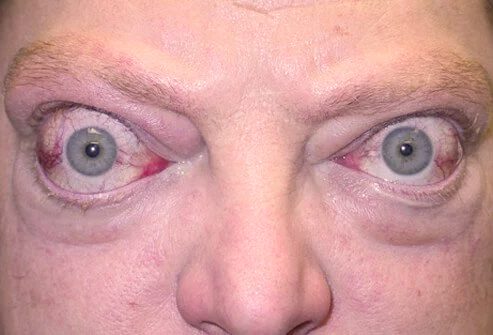Contents
Exophthalmos (bulging eyes)
How is exophthalmos defined?
Exophthalmos is the term used to refer to the protrusion of one or both eyes outside the orbit. We also speak of eyes or bulging eye (s).
The eye appears larger, more “open”, which can interfere with the closing of the eyelid in addition to causing aesthetic discomfort. Exophthalmos is not due to an increase in the size of the eye, but rather an increase in the size of the muscles or structures inside the eye (possible presence of a lump in the eye). orbit). The bulging eye may also be deviated and appear to be looking in a different direction from the normal eye. In most cases, however, both eyes are affected.
Exophthalmos may be isolated or associated with other symptoms, such as reduced visual acuity, double vision (diplopia), pain, redness, etc.
Exophthalmos can be blatant and disfiguring, but it is not always immediately obvious: it can also be discovered during a routine eye exam.
What are the causes of exophthalmos?
There are several possible causes of exophthalmos: endocrine, tumor, inflammatory, traumatic and vascular.
The ophthalmologist will assess the unilateral or bilateral nature of the disorder, its course (rapid or not), whether the eye is deflected or not (“axillary” or non-axillary character), and the feeling of a “pulse” or a pulsation in the eye (pulsatile character).
In general, the sudden onset of exophthalmos is more like a trauma or an inflammatory disease. When it sets in gradually, it is rather caused by endocrine or tumor pathology.
Here are the most common causes:
- Graves’ disease: this is a disease of the thyroid gland (hyperthyroidism) generally of autoimmune origin. It indirectly causes inflammation of the tissues of the eyeball, which swell and cause the eye to protrude. Other thyroid disorders may be involved (we speak of dysthyroid orbitopathy in general: hyperthyroidism in 80% of cases, hypothyroidism in about 10%). Most often, exophthalmos is bilateral.
- carotid-cavernous fistula: this is the cause frequently found when the exophthalmos is unilateral and pulsatile. It is an abnormal communication between the internal carotid and the cavernous sinus (venous formation located at the base of the skull), often due to trauma. It is a medical emergency, even life-threatening.
- Traumatic exophthalmos: they occur after a shock (hematoma, fracture of the orbit, etc.) or a head trauma.
- Infectious exophthalmos: these are most often the consequences of ethmoiditis, that is to say an infection of the ethmoid, a bone located between the two eye sockets. It mainly affects children and adolescents.
- Inflammatory exophthalmos: their cause is not always known, but they can be associated with certain systemic diseases such as sarcoidosis, periarteritis nodosa, Wegener’s disease, inflammatory vasculitis, etc. They can also be linked to an orbit abscess, orbital mycosis, cellulitis, etc.
- Tumor exophthalmos: they are due to the presence of a tumor mass in the eyeball. Many types of tumors can affect this area. It can also be metastases from another site.
What are the consequences of exophthalmos?
In addition to the unsightly aspect of exophthalmos, it can interfere with vision, be accompanied by pain, complications that endanger vision… It is therefore essential to consult your ophthalmologist quickly.
This has several instruments to assess the severity of the exophthalmos. Most often, he will prescribe imaging examinations (CT scan, MRI) to establish the diagnosis.
What are the solutions in case of exophthalmos?
Treatment for exophthalmos depends on the cause. It is either medical or surgical.
In the event of thyroid disease, which is the most common cause, taking an antithyroid drug over several months often helps restore normal thyroid hormone levels. Surgical removal of the thyroid and taking radioactive iodine may also be suggested, depending on the case.
Exophthalmos does not always improve with treatment: it is sometimes even exacerbated by it. Taking corticosteroids can help, and sometimes surgery may be indicated, after hormone levels are restored.
In other cases of exophthalmos, depending on the cause, several solutions may be considered. The results depend on the condition and the underlying disease.











казакстанда экзофтальм ды емдитин жер барма